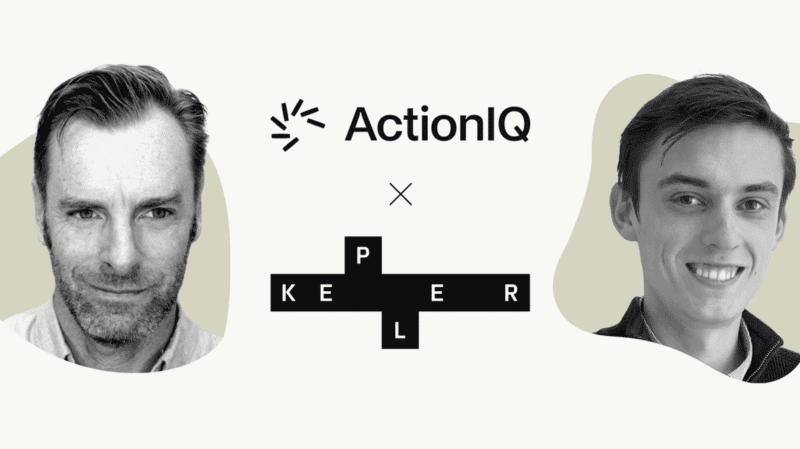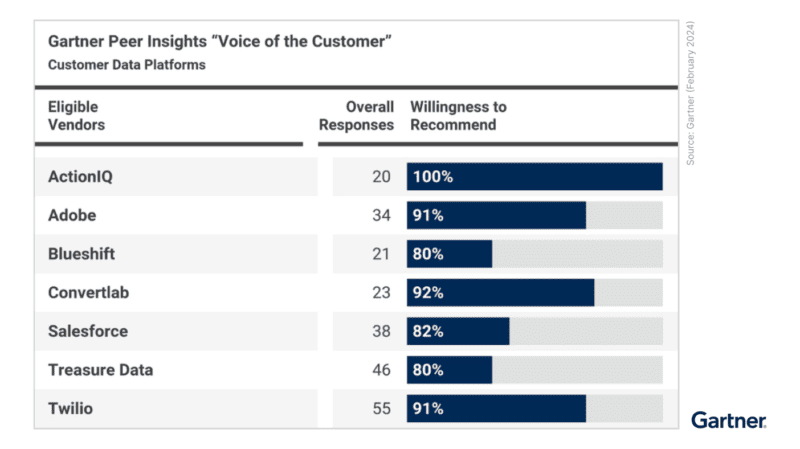The New Adtech Paradigm: A Q&A With Kepler Group and ActionIQ

Marketing and advertising professionals are more than aware of the massive disruptions in the martech and adtech industry. Those on the ad agency side are also acutely aware of the disruptions occurring with the death of third-party cookies as well as adtech platforms that were built on top of that cookie foundation — like the DMP. This means increasing difficulty to target and deliver relevancy of messaging at a personalized basis at scale. The ability for a brand to drive awareness, incrementality and market-share is becoming less effective and more expensive.
There are also new innovations being supercharged by these disruptions. Most relevant being the convergence across adtech, martech and cloud-based data infrastructure. Within that umbrella, you have customer data platforms (CDPs) like ActionIQ, that have taken a leading role in moving into the upper-funnels of acquisition marketing, and bringing to market a centralized audience and activation platform that interoperates across identity spaces replacing the third-party cookie.
As a result, we are seeing a preponderance of ad agencies (large and small) exploring and defining services practices, licensing, partnering, participating in review cycles with their brand customers, and/or being active users of a CDP within a brand instance.
So what does this all mean for an ad agency in terms of adoption? How can agencies apply their planning, test and control cycles within a CDP? What about adjacent applications across media planning, measurement and reporting, and modeling?
In this conversation with Nick Howe, Associate Director of Marketing Systems Strategy at Kepler Group, we’ll discuss how these changing trends are contributing to shared pathways between ad agencies and CDPs, and what this relationship looks like for brands and their ad strategy.
The New Adtech Paradigm: A Q&A With Kepler Group and ActionIQ
How did you get started in the industry?
Zach Van Doren: My career has spanned across media, analytics, adtech and martech. I started my career in paid search — which gave me a data-driven digital advertising foundation — and from there evolved into media planning and strategy; and then into consulting across media analytics, tagging, customer data; and then into customer data platforms. I have very much enjoyed being in a front row seat to all this convergence, and as with my media background comes full circle with CDPs taking an increasingly significant role in acquisition marketing post-DMPs.
Nick Howe: I’ve been in different roles at Kepler for my entire career. I started in media planning then went to analytics data. Our trajectory changed with the announcement of third-party cookies, making Kepler a marketing system strategic partner to help clients adapt to the changing landscape. As an agency we help brands design efficient operations and marketing programs.
How have you seen ad agencies and CDPs interact in the past?
Zach Van Doren: There is a limited history of agencies and CDPs, and also a missed opportunity. While the mission of CDPs has always been to democratize customer data to the marketing user — it is often the case that these marketing teams lack the training, expertise and/or processes in place to really handle the scale of such data. The traditional use cases being within the post-sale/lead, retention marketing realm. So the hands-on-keyboard users are the channel managers within that space — email, web personalization, loyalty, CRM, etc. Then imagine what happens when you put into their hands a level of data complexity that extends across hundreds of thousands to millions of customer rows and then dozens to hundreds of column attributes.
Ad agencies, on the other hand, have spent years building audience segmentation, targeting and communication expertise, working across prospect data of scale and complexity within their media planning and management cycles. This has been the essence of both the gap and the opportunity. Agencies like Kepler are thought leaders in ad innovation, moving the needle with audience planning while being GDP compliant with the breadth of data brands have.
Nick Howe: The agency role hasn’t changed — advertising is always going to be there so it needs to be targeted and relevant. But there is a shift in focus as successful agencies incorporate supporting and maintaining martech implementation into their service offering. Ad agencies have and continue to own the day to day operations of their client’s ad campaigns across platforms. Now that first-party audiences will play a larger role in ad campaigns, it makes even more sense for a successful agency and client relationship to include access to a CDP. Combining the CDP and agency team helps clients set up use cases that will be most valuable to them. At Kepler, we help CDPs receive buy-in from different clients required to approve CDPs and their use-cases, including legal buy-in (like how they are transporting sensitive customer data) and financial buy-in by clearly laying out how ROI of the tool will be measured.
What trends are contributing to emerging shared pathways between ad agencies and CDPs?
Zach Van Doren: It’s very interesting to see this convergence of martech and adtech, kind of coming full circle. With all the disruption in the market we’re seeing right now, the predominance of first-party data is becoming a core data foundation with tools like DMPs going away. Then you have big clouds like Snowflake and Databricks creating customer 360 environments which is driving even more innovation. I believe what is most exciting in all of this disruption is the convergence between CDPs and the cloud providers, which creates the basis for agencies to connect their planning and reporting tool-kits as part of a fully integrated CX stack.
Nick Howe: Many of our clients have begun inviting us and the CDP account teams into meetings with their legal and infosec teams. With first-party data playing a bigger role in a marketing program, there is going to be more focus on governance of that data. I think a good agency helps their clients by acting as a translator between marketing teams and infosec and legal teams. We see our role as making sure legal and infosec stakeholders are clear on how customer data will be used in marketing platforms and the security measures that are in place so they have all necessary information to approve the use cases. This is why tight alignment with CDPs and agencies is important to establish compliance.
How do ad agencies and CDPs play into identity?
Zach Van Doren: From the technology vantage point and as a CDP, we are seeing a clear need in allowing brands and agencies to interoperate across different ID spaces that are replacing the third-party cookie. This includes a range of different providers and options across the walled gardens such as Google Conversion API, identity tokens such as UID2, and identity spines such as Neustar, LiveRamp and Merkury. As a consequence, this has opened up a completely new planning paradigm that agencies can/should own, that is the Identity Stack, which correlates to a brands media mix, martech stack, etc. — all towards the objective of maximizing addressability and reach of their customers and prospects.
Nick Howe: Agencies and CDP teams are well positioned to collaborate on helping clients navigate how and where to activate and where addressability and reach can be maximized. Two methods that we’ve seen success for our clients when collaborating with CDPs are onboarding an identity enrichment platform and implementing server-side tracking. In terms of identity spines, CDPs are a great way for brands to easily integrate identity enrichment partners. Agencies can assist in activating enriched audiences across ad platforms as well as set up tests to measure the incremental impact.
Regarding server-side tracking, Kepler now sees this as a need-to-have in any future-proofed marketing tech stack due to the increasing privacy regulations. A CDP, which is already collecting event-level data, is probably the easiest method through which to set up serverside tracking with different ad platform APIs. As we approach the deprecation of third-party cookies, maximizing audience signals will be crucial to maintaining scale and reach. Agencies and CDPs should present a united front to tackle these coming changes for their clients.
What do agencies bring to a CDP deployment?
Nick Howe: Brands will always get pressure from their procurement teams to onboard and measure the ROI of a CDP quickly. But I think that puts at risk that discovery planning and kind of having a haphazard setup that’s good for nobody.
An ad agency alone or a CDP support team alone would have trouble convincing and disciplining the brand to make sure that discovery phase is comprehensive and well thought out. But I think together, it’s kind of two versus one — let’s stay disciplined about this discovery phase so that the setup that we ultimately arrive at is sustainable, because it’s a lot harder to fix once the foundation is set up. So let’s get the foundation right.
Zach Van Doren: Agencies have the resources, experience and expertise to manage complex profiles and audiences that retention marketers don’t necessarily have. This combined intricate knowledge of adtech platforms that manage the placement of digital media, fed from first-party audiences from the CDP. Ad agencies also have measurement and modeling expertise to help in closing the loop across first party audiences, creative, placement and behaviors — expertise that enterprise organizations don’t always have in-house.
Wherever there are paid media use cases involved in a CDP deployment where the agency partner is responsible for managing these media channels, it’s very important that the agency is involved as an active party in the pre-planning and deployment process. This can include driving strategy around audience segmentation design, activation and onboarding methodology and identity portfolio strategy as mentioned above. All of this will have a material impact in driving how IT and data teams design and deploy the CDP relative to a brand’s data and martech stack.
How should organizations transition from a DMP to a CDP?
Zach Van Doren: It’s important to keep in mind the original vision and intent of the DMP, which is to enable person-based advertising at scale. This is all done through the centralization of profile-based audiencing and activation functions across prospecting, retargeting, personalization, onboarding of first-party data, blending with third-party data etc. All of this course was built on top of the third-party cookie.
To move from a DMP to a CDP relative to this vision requires a deconstruction and rebuild in terms of how tactically a brand and agency would enable those core acquisition use cases. So again, the identity portfolio as a planning piece becomes essential; and then don’t expect a 1:1 parity between a DMP and a CDP as it relates to this transition.
Nick Howe: When transitioning from a DMP to a CDP, efficient scale is always going to be the name of the game with digital marketing dollars. One thing that’s going to be difficult is that a first-party audience alone may not give you the remarketing scale — when transitioning from a DMP to a CDP it is essential to figure out what the new identity resolution and third-party data enrichment looks like, from a privacy centric way.
How and why should ad agencies adopt CDPs within their planning cycles?
Zach Van Doren: Moving beyond deployment and into ongoing management cycles, we are finding tremendous benefit where agency teams have hands-on-keyboard access to a brand’s CDP instance. It goes back to the core mission in democratizing the brand’s first-party data to marketing teams and empowering those teams to fully execute on personalized communication and CX delivery. By allowing the media teams that are running the media channels access provides them in turn that same level of execution power. This includes audience discovery, sizing, testing and iteration across a variety of audience types. As this advances, this can then include adjacent technologies that agencies can bring to the stack including modeling, reporting, media planning, etc.
Nick Howe: I would agree entirely with what Zach said. What I’ll add is that technical advancements in how platforms are able to identify high propensity prospects (within their walled gardens) should incentivize brands to securely and with consent provide adtech platforms with as much 1st-party customer data as possible to help platforms reach the right users. Agencies can leverage their expertise on ad platforms’ algorithms and audience tools, as well as their often priority access to newly released platform tools, to meaningfully contribute to a brand’s audience strategy and maximize the utility of their client’s 1st-party data across their marketing program.
Additionally, effective planning still involves creativity. With direct access to a brand’s CDP, agencies can put together more comprehensive and interesting media plans that include a wider range of audiences than just, say, past purchasers. Agency access can also reduce turnaround time for media plans. Often, our media planning cycles with our clients involve somewhat tedious back-and-forth in order to figure out if a proposed audience exists or what the size of a certain audience is. By incorporating their agency into the CDP, a brand can delegate the work required to sift through their audience library to the agency so that a media plan can be agreed upon more quickly.
Design an Adtech Partner Ecosystem with Ad Agencies and CDPs
Having the right partners around to support your ad strategy in the middle of one of the biggest inflections in industry history helps you drive growth in a weathered environment, while future-proofing you against any changes ahead.
With the convergence of adtech, martech and cloud-based data infrastructure, CDPs like ActionIQ have taken a leading role in moving into the upper-funnels of acquisition marketing with a centralized audience and activation platform that interoperates across identity spaces replacing the third-party cookie.
Reach out to our experts to learn more about how we ActionIQ can support your ad strategy.





